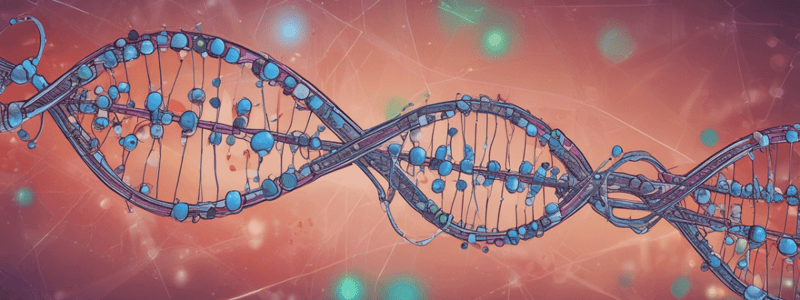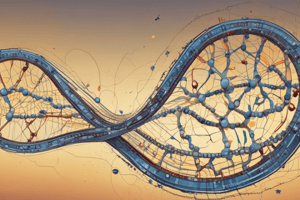Podcast
Questions and Answers
What is the function of Selenocisteina in proteins?
What is the function of Selenocisteina in proteins?
- To stabilize protein structure
- To introduce selenium into proteins
- To form disulfide bonds
- To act as an antioxidant in redox reactions (correct)
What is the origin of Pirrolisina?
What is the origin of Pirrolisina?
- Derived from lysine (correct)
- Derived from serine
- Derived from glutamine
- Derived from cysteine
What is the function of the third base in codon recognition?
What is the function of the third base in codon recognition?
- It increases the specificity of tRNA binding
- It has become more important with the emergence of new amino acids (correct)
- It is not important for codon recognition
- It determines the reading frame
What is the hipótesis estereoquímica based on?
What is the hipótesis estereoquímica based on?
What is the consequence of the hipótesis del accidente congelado?
What is the consequence of the hipótesis del accidente congelado?
What is unique about the codon UGA in some proteins?
What is unique about the codon UGA in some proteins?
What is the main difference between Selenocisteina and cisteina?
What is the main difference between Selenocisteina and cisteina?
In which organisms is Pirrolisina found?
In which organisms is Pirrolisina found?
What is the result of the co-evolution of the genetic code?
What is the result of the co-evolution of the genetic code?
What is the function of the tRNA that recognizes the codon UAG in Candida?
What is the function of the tRNA that recognizes the codon UAG in Candida?
Flashcards are hidden until you start studying
Study Notes
The Genetic Code
- The genetic code is contained in DNA, transcribed to mRNA, and translated into proteins.
- The code is degenerate, meaning that multiple codons can code for the same amino acid.
Central Dogma
- The central dogma states that DNA is transcribed into mRNA, which is then translated into proteins.
- The process does not involve a code, but rather the synthesis of mRNA through base pairing.
Cracking the Genetic Code
- The genetic code was cracked through a series of experiments, including:
- Synthesizing poly(U) and poly(A) to test codon combinations.
- Using ribosomes to translate synthesized RNA.
- Determining the sequence of nucleotides in tRNA.
- The code was found to be degenerate, with multiple codons coding for the same amino acid.
Codon Assignment
- Codons were assigned to amino acids through experimentation.
- The first position of the codon is most important in determining the amino acid.
- The second position is also important, while the third position is less important.
- Some amino acids have multiple codons, while others have only one.
tRNA and the Wobble Hypothesis
- tRNA recognizes codons through complementary base pairing.
- The Wobble Hypothesis states that the third base of the codon can undergo non-canonical pairing, allowing a single tRNA to recognize multiple codons.
- This allows for degeneracy in the code and reduces the number of tRNAs needed.
Codon Bias and Optimal Codons
- Codon bias refers to the preference for certain codons over others in an organism.
- Optimal codons are those that are used most frequently and are recognized by abundant tRNAs.
- The use of optimal codons can affect the speed of translation and the efficiency of protein synthesis.
- Non-optimal codons can cause ribosome stalling and affect protein synthesis.
Summary
- The genetic code is degenerate, with multiple codons coding for the same amino acid.
- Codon assignment was determined through experimentation.
- tRNA recognizes codons through complementary base pairing, and the Wobble Hypothesis explains degeneracy in the code.
- Codon bias and the use of optimal codons can affect protein synthesis.### Non-Optimal Codons and Protein Synthesis
- Non-optimal codons produce less protein and have reduced stability, leading to ribosome stalling and degradation.
- Rapid translation is not always beneficial, as it can lead to misfolding.
Regulation of Gene Expression by tRNAs
- In multicellular organisms, tRNA population varies between cells undergoing differentiation or proliferation.
- Cells undergoing differentiation have a tRNA population that translates specific mRNAs, while proliferating cells have a tRNA population enriched for specific codons.
- In tumors, cell populations switch from a differentiated to a proliferative state, altering tRNA expression and promoting metastasis.
Suppressor tRNAs
- Mutations in the anticodon of a tRNA can cause it to read a different codon, leading to mistranslation and mutations.
- Such mutations can be difficult to recognize.
Mitochondrial Genetic Code
- Mitochondria have a reduced genetic code with fewer tRNAs due to genomic pressure.
- The code has evolved independently, with changes such as stop codons becoming tryptophan codons.
Universality of the Genetic Code
- The genetic code is universal, but there are exceptions in nuclear genomes.
- Some organisms have modified codons, such as Mycoplasma capricolium, where UGA codes for tryptophan.
New Amino Acids
- Selenocysteine (Sec) is the 21st amino acid, found in all organisms, and has antioxidant properties.
- Pyrrolysine (Pyl) is the 22nd amino acid, found only in eubacteria and archaea, and is encoded by the UAG codon.
Origin and Evolution of the Genetic Code
- The "frozen accident" hypothesis proposes that the genetic code arose randomly and was frozen in place.
- The stereochemical hypothesis suggests that the code arose from direct interactions between RNA and amino acids.
- The co-evolution hypothesis proposes that the code co-evolved with the expansion of the amino acid repertoire.
Studying That Suits You
Use AI to generate personalized quizzes and flashcards to suit your learning preferences.




